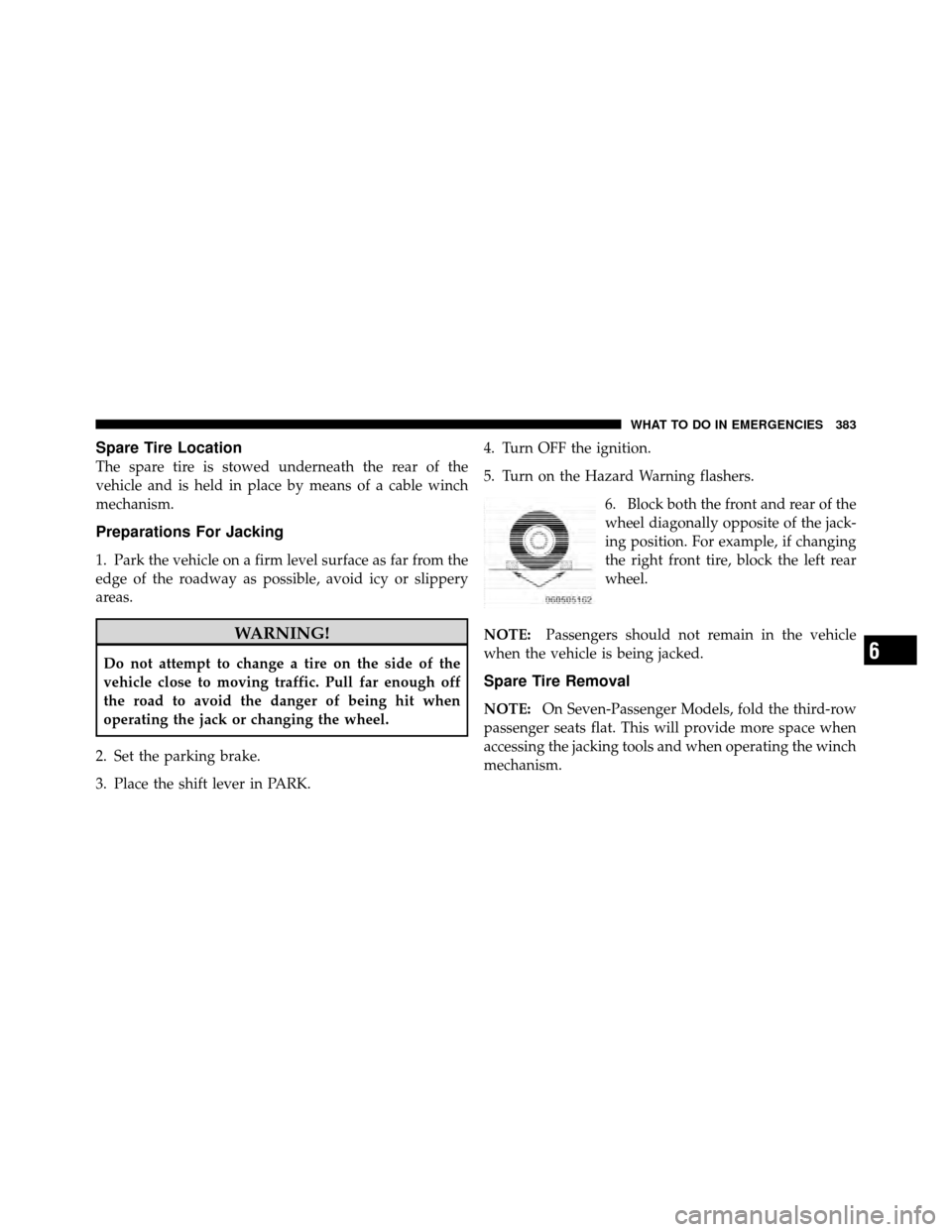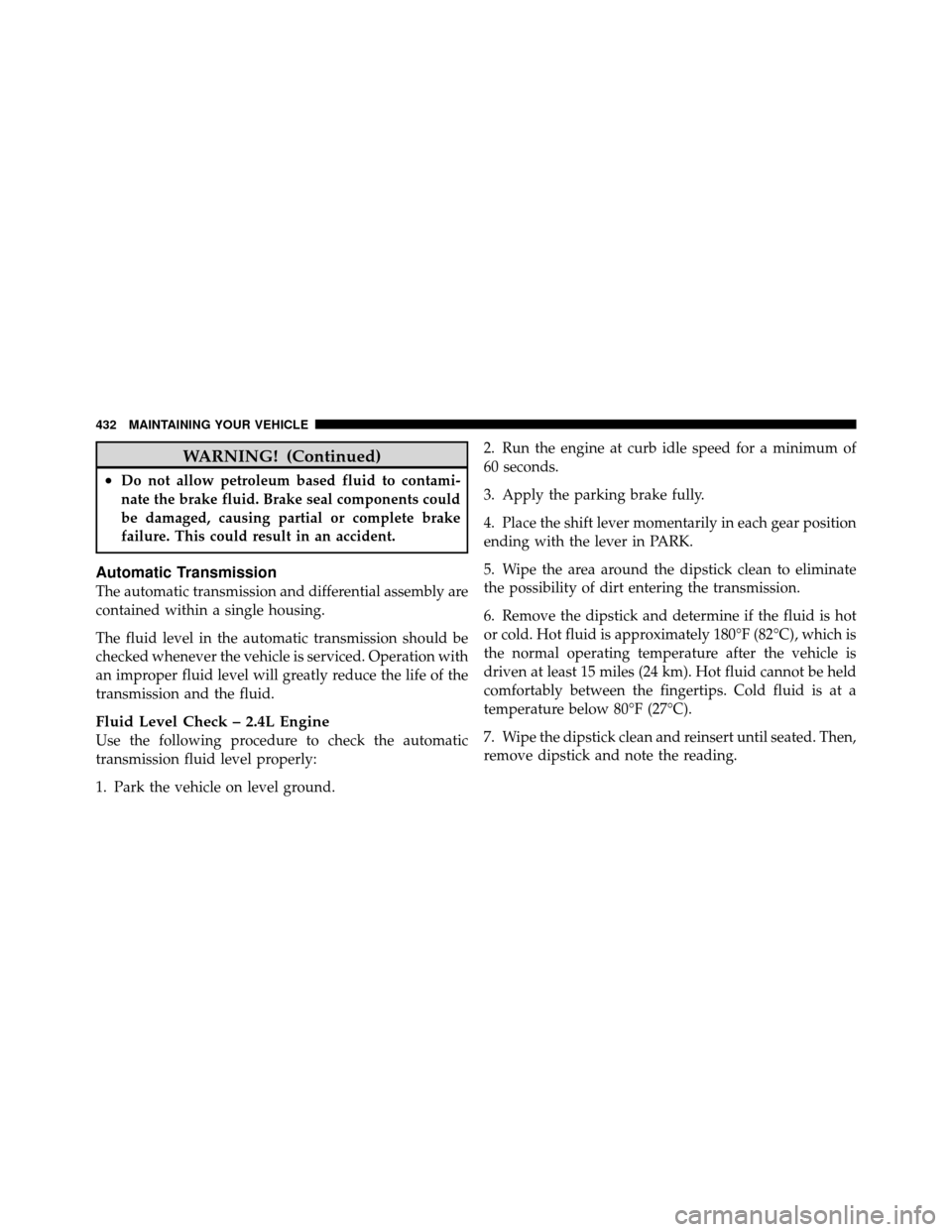Page 384 of 512

Spare Tire Location
The spare tire is stowed underneath the rear of the
vehicle and is held in place by means of a cable winch
mechanism.
Preparations For Jacking
1. Park the vehicle on a firm level surface as far from the
edge of the roadway as possible, avoid icy or slippery
areas.
WARNING!
Do not attempt to change a tire on the side of the
vehicle close to moving traffic. Pull far enough off
the road to avoid the danger of being hit when
operating the jack or changing the wheel.
2. Set the parking brake.
3. Place the shift lever in PARK. 4. Turn OFF the ignition.
5. Turn on the Hazard Warning flashers.
6. Block both the front and rear of the
wheel diagonally opposite of the jack-
ing position. For example, if changing
the right front tire, block the left rear
wheel.
NOTE: Passengers should not remain in the vehicle
when the vehicle is being jacked.
Spare Tire Removal
NOTE: On Seven-Passenger Models, fold the third-row
passenger seats flat. This will provide more space when
accessing the jacking tools and when operating the winch
mechanism.
6
WHAT TO DO IN EMERGENCIES 383
Page 388 of 512
4. Tilt the retainer at the end of the winch cable and drop
it through the center of the wheel. Then place the spare
tire with the cable and retainer underneath the vehicle.
5. Fit the assembled jack-handle over the winch drive
nut. Rotate the jack-handle assembly clockwise to raise
the spare tire into the storage area. Continue to rotate thejack-handle assembly until you hear the winch mecha-
nism click three times. It cannot be over tightened. Push
against the tire several times to be sure it is held securely
in place.
Jacking Instructions
WARNING!
Carefully follow these tire changing warnings to
help prevent personal injury or damage to your
vehicle:
•Always park on a firm, level surface as far from
the edge of the roadway as possible before raising
the vehicle.
•Block the wheel diagonally opposite the wheel to
be raised.
•Set the parking brake firmly and set an automatic
transmission in PARK.
(Continued)
Spare Tire Retainer
6
WHAT TO DO IN EMERGENCIES 387
Page 395 of 512

WARNING!
•Take care to avoid the radiator cooling fan when-
ever the hood is raised. It can start anytime the
ignition switch is on. You can be injured by
moving fan blades.
•Remove any metal jewelry such as watch bands or
bracelets that might make an inadvertent electrical
contact. You could be seriously injured.
•Batteries contain sulfuric acid that can burn your
skin or eyes and generate hydrogen gas which is
flammable and explosive. Keep open flames or
sparks away from the battery.
1. Set the parking brake, shift the automatic transmission
into PARK and turn the ignition to LOCK.
2. Turn off the heater, radio, and all unnecessary electri-
cal accessories. 3. Remove the protective cover over the remote positive
(+)
battery post. To remove the cover, press the locking
tab and pull upward on the cover.
4. If using another vehicle to jump-start the battery, park
the vehicle within the jumper cables reach, set the
parking brake and make sure the ignition is OFF.
Locking Tab
394 WHAT TO DO IN EMERGENCIES
Page 433 of 512

WARNING! (Continued)
•Do not allow petroleum based fluid to contami-
nate the brake fluid. Brake seal components could
be damaged, causing partial or complete brake
failure. This could result in an accident.
Automatic Transmission
The automatic transmission and differential assembly are
contained within a single housing.
The fluid level in the automatic transmission should be
checked whenever the vehicle is serviced. Operation with
an improper fluid level will greatly reduce the life of the
transmission and the fluid.
Fluid Level Check – 2.4L Engine
Use the following procedure to check the automatic
transmission fluid level properly:
1. Park the vehicle on level ground.2. Run the engine at curb idle speed for a minimum of
60 seconds.
3. Apply the parking brake fully.
4. Place the shift lever momentarily in each gear position
ending with the lever in PARK.
5. Wipe the area around the dipstick clean to eliminate
the possibility of dirt entering the transmission.
6. Remove the dipstick and determine if the fluid is hot
or cold. Hot fluid is approximately 180°F (82°C), which is
the normal operating temperature after the vehicle is
driven at least 15 miles (24 km). Hot fluid cannot be held
comfortably between the fingertips. Cold fluid is at a
temperature below 80°F (27°C).
7. Wipe the dipstick clean and reinsert until seated. Then,
remove dipstick and note the reading.
432 MAINTAINING YOUR VEHICLE
Page 490 of 512

Auto Unlock, Doors....................... 30
Automatic Dimming Mirror ................. 95
Automatic Door Locks ..................... 30
Automatic Headlights .................... 122
Automatic Oil Change Indicator ..........188,205
Automatic Temperature Control (ATC) ......... 277
Automatic Transaxle ................... 298,432
Adding Fluid ................... 432,434,457
Filter ............................... 434
Fluid and Filter Changes ................. 434
Fluid Level Check ................... 432,434
Interlock System .................... 300,301
Reset Mode .......................... 304
Selection Of Lubricant ................... 457
Shifting ............................. 298
Special Additives ...................... 434
Autostick ............................. 305
Auxiliary Electrical Outlet (Power Outlet) ...... 150
Auxiliary Power Outlet ................... 150 Back-Up Lights
......................... 452
Battery ............................... 413
Charging System Light .................. 190
Keyless Transmitter Replacement (RKE) ....... 24
Location ............................ 413
Belts, Seat ............................ 41,86
Body Mechanism Lubrication ............... 417
Booster Seat ............................ 73
B-Pillar Location ........................ 331
Brake Assist System ...................... 319
Brake Assist Warning Light ................. 194
Brake Control System, Electronic ............. 317
Brake Fluid ............................ 457
Brake, Parking .......................... 312
Brake System ........................ 315,430
Anti-Lock (ABS) .................... 316,317
Fluid Check ....................... 430,457
Master Cylinder ....................... 430
Parking ............................. 312
10
INDEX 489
Page 502 of 512

Navigation Radio (Uconnect�gps)........... 251
Navigation System (Uuconnect� gps)....... 137,251
New Vehicle Break-In Period ................ 83
Occupant Restraints ................... 39,61,66
Occupant Restraints (Sedan) ...........57,58,61,64
Octane Rating, Gasoline (Fuel) ............353,456
Odometer Trip ............................. 190,197
Oil Change Indicator .................. 188,205
Oil Change Indicator, Reset ..............188,205
Oil, Engine ......................... 409,456
Capacity ............................ 455
Change Interval .................. 188,205,410
Checking ............................ 409
Dipstick ............................. 409
Disposal ............................ 412
Filter ............................ 412,456
Filter Disposal ........................ 412 Identification Logo
..................... 410
Materials Added to ..................... 411
Recommendation ................... 410,455
Synthetic ............................ 411
Viscosity .......................... 41 1,455
Oil Filter, Change ........................ 412
Oil Filter, Selection ....................... 412
Onboard Diagnostic System ..............405,406
Opener, Garage Door (HomeLink�) ........... 140
Operating Precautions .................... 405
Outside Rearview Mirrors .................. 95
Overdrive .......................... 186,303
Overhead Console ....................... 139
Overheating, Engine ................... 184,380
Owner’s Manual (Operator Manual) .......... 483
Paint Care ............................. 435
Panic Alarm ............................ 23
Parking Brake .......................... 312
10
INDEX 501
Page:
< prev 1-8 9-16 17-24